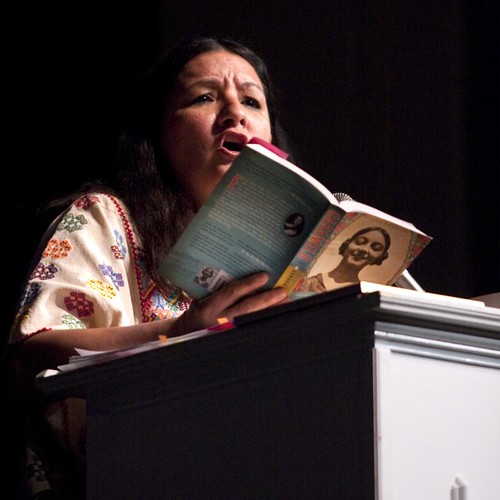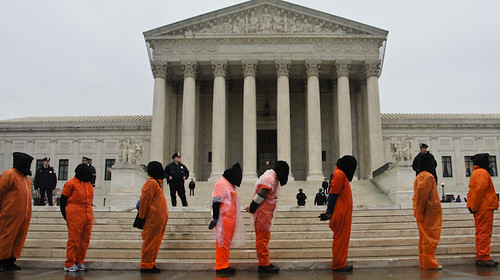Have you noticed how it is the conservatives who are the quickest to ban books, who are afraid of ideas that challenge them?
Here is an example, the 6 Books Banned Thanks to Arizona's Ban of Ethnic Studies. Conservatives are terribly threatened by people celebrating or learning about their origins, they are frightened by diversity. The ONLY acceptable heritage to be taught in their minds is western European. They view the rest of the world as inferior -- and scary, VERY scary.
I am stunned by how many books have gone from required reading, K-12, to being banned. The Tempest was one of the first Shakespeare works I ever read, around age 10 or so. My parents gave me written permission to read books from the adult section of our local library when I was 8. Any attempts by adults to deny me access to books deeply angered me; I figured if I was capable of reading them, and found them interesting or educational, that was my business, not theirs.
Since Banned Book week began, over 11,000 books have been banned. These represent the books banned in just one state, and then only recently. The problem is older, and much larger, and it is repressive.
From Care2:
6 Books Banned Thanks To Arizona’s Ban of Ethnic Studies
by Kristina Chew October 4, 2012 6:00 am
Just over a year ago, a controversial ban (HR 2281) on ethnic studies classes in Arizona public schools went into effect. The law bans classes that “promote the overthrow of the United States government and resentment toward a race or class of people” and also prohibits courses that are designed “primarily for students of a particular ethnic group and those that advocate ethnic solidarity rather than treat students as individuals.” Critics, such as Care2′s Amelia Thomson-Deveaux, contended that the “law openly discriminates against minorities”; certainly the political climate in Arizona has been “unspeakably hostile to immigrants and minorities.”
The ban was proposed in response to the 13-year-old Mexican American history program in the Tucson Unified School District, in which more than 60 percent of the students are from Mexican American backgrounds. Noting that their courses are open to all students, the Tucson school district was initially not worried about the ban. But after being told that it would face a multimillion dollar penalty in the form of the loss of state funds, the district’s governing board has ended the Mexican-American history program.
In addition to the ethnic studies ban, the Tucson school district released a list of books that will be banned from its schools. A number of books from Mexican American studies classrooms have reportedly been boxed up and removed from classrooms.
Debbie Reese at American Indians in Children’s Literature (ACLC) has posted a list of the books from an audit of Tucson’s Mexican American Studies program; the findings were published in May of 2011. She writes that “At this point is is not known if all the books listed below were boxed and removed. They were placed in storage.”
Jeff Biggers at Salon has reviewed the list and found that it contains
I suppose you could say that it is a bit ironic that the state of Arizona, in the name of banning books about such “themes,” is conducting its own campaign of suppression of knowledge and learning in an effort resembling the tactics of repressive regimes.
Here is an example, the 6 Books Banned Thanks to Arizona's Ban of Ethnic Studies. Conservatives are terribly threatened by people celebrating or learning about their origins, they are frightened by diversity. The ONLY acceptable heritage to be taught in their minds is western European. They view the rest of the world as inferior -- and scary, VERY scary.
I am stunned by how many books have gone from required reading, K-12, to being banned. The Tempest was one of the first Shakespeare works I ever read, around age 10 or so. My parents gave me written permission to read books from the adult section of our local library when I was 8. Any attempts by adults to deny me access to books deeply angered me; I figured if I was capable of reading them, and found them interesting or educational, that was my business, not theirs.
Since Banned Book week began, over 11,000 books have been banned. These represent the books banned in just one state, and then only recently. The problem is older, and much larger, and it is repressive.
From Care2:
6 Books Banned Thanks To Arizona’s Ban of Ethnic Studies
by Kristina Chew October 4, 2012 6:00 am
Just over a year ago, a controversial ban (HR 2281) on ethnic studies classes in Arizona public schools went into effect. The law bans classes that “promote the overthrow of the United States government and resentment toward a race or class of people” and also prohibits courses that are designed “primarily for students of a particular ethnic group and those that advocate ethnic solidarity rather than treat students as individuals.” Critics, such as Care2′s Amelia Thomson-Deveaux, contended that the “law openly discriminates against minorities”; certainly the political climate in Arizona has been “unspeakably hostile to immigrants and minorities.”
The ban was proposed in response to the 13-year-old Mexican American history program in the Tucson Unified School District, in which more than 60 percent of the students are from Mexican American backgrounds. Noting that their courses are open to all students, the Tucson school district was initially not worried about the ban. But after being told that it would face a multimillion dollar penalty in the form of the loss of state funds, the district’s governing board has ended the Mexican-American history program.
In addition to the ethnic studies ban, the Tucson school district released a list of books that will be banned from its schools. A number of books from Mexican American studies classrooms have reportedly been boxed up and removed from classrooms.
Debbie Reese at American Indians in Children’s Literature (ACLC) has posted a list of the books from an audit of Tucson’s Mexican American Studies program; the findings were published in May of 2011. She writes that “At this point is is not known if all the books listed below were boxed and removed. They were placed in storage.”
Jeff Biggers at Salon has reviewed the list and found that it contains
- Pedagogy of the Oppressed by Brazilian educator Paolo Freire (about the author’s “search for a way to fashion education into a transformative tool for individuals and society“)
- Occupied America: A History of Chicanos by Rodolfo Acuña (described as “one of the few books that offers a comprehensive, in-depth analysis of the major historical experiences of Chicanos that invokes critical thinking and intellectual discussion”)
I suppose you could say that it is a bit ironic that the state of Arizona, in the name of banning books about such “themes,” is conducting its own campaign of suppression of knowledge and learning in an effort resembling the tactics of repressive regimes.







No comments:
Post a Comment